Sunday, September 20 On Monday morning, Christi picked up some rubber o-rings for the watermaker fresh water filter housing. Eric changed out the rings out when he got home from work. Unfortunately, that didn’t do the trick in terms of stopping the leak, so more investigation is going to be needed to figure out the source of the leak. It looks like the filter might not be fitting just right.
We forgot to mention that a few weeks ago, Eric and his dad went to see an IMAX movie called “Under the Sea“. Eric was astounded at the underwater scenery many of the scenes looked exactly like some of the places we have been diving. When the credits rolled, he figured out why. The movie was shot in five places, 2 spots in Papua New Guinea, 2 spots in Australia, and one in Indonesia. We went diving in two of the same places — the Great Barrier Reef and around Komodo National Park, so that explains why the settings were so familiar. Seeing the credits was a moment where Eric counted his blessings. This company had chosen the most spectacular dive spots in the world and we were at two of them. Wow.
Anyway, since then, we have been thinking we should go to the local aquarium. It is called the Stephen Birch Aquarium and is tied to the Scripps Institute of Oceanography Research at the University of San Diego. Eric hasn’t been there for many years and Christi has never been. We wanted to see how it compares to some of the other impressive aquariums we have been to, such as the ones in Atlanta, Monaco and Crete. But really, more than anything, we wanted to re-live our much missed underwater lifestyle. The water in San Diego is way too cold and generally too murky for us to consider diving in.
So, today we went to the aquarium with Eric’s parents. We were there right when they opened. Here is the whale sculpture out front:
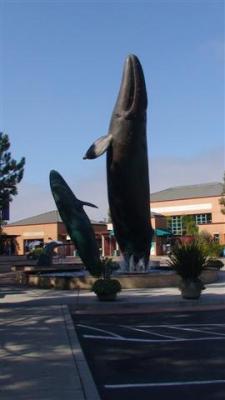
Surprisingly enough, the Birch aquarium was first built in 1903, back in the day when the study of the ocean was a relatively new field of science. However, unlike Monaco, which still uses their original building built in 1910, the Birch Aquarium has relocated to a modern facility built in 1992. The aquarium is divided into two halves. One half has quite a few tanks with ecosystems of sea life. The other half has a lot of informational displays and a few species of individual fish on display. The tank portion of the facility is smaller than all three aforementioned aquariums, but the informational section is bigger than in both Crete and Atlanta. There is also an outdoor area with touch pools.
We started with the tank section. There are over 60 tanks, but most are fairly small. Most of the displays feature ecosystems indigenous to the Pacific Coast of North America, with displays ranging from the cold waters of the Pacific Northwest to somewhat warmer waters of Southern Mexico. They also threw in a few tropical exhibits from the Caribbean. The largest tank of all features a kelp forest, which is indigenous to San Diego’s local ecosystem. The tank holds 70,000 gallons (266,000 liters) and is fed by natural seawater flowing in and out from the ocean right behind the building.
As we walked through the exhibits, Eric and Christi excitedly pointed out to Eric’s parents all the fish and coral we have seen on our assorted dives, such as butterfly fish, surgeon fish, trigger fish, lion fish, reef sharks, and many of the tropical corals. Here is a tropical exhibit:
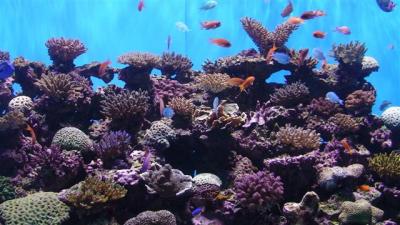
We also spent a fair amount of time looking at the sea life in the colder water tanks, since we will likely never see them for ourselves in the water. There are some cool cold water creatures. Here is Eric’s dad watching jelly fish.
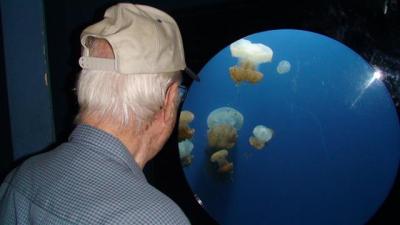
When we finished in the tank area, we went over to the informational displays. Most of the displays are oriented towards kids, and are fun. There was a series of displays on camouflaged sea creatures that was super cool. We saw familiar creatures, like flounder and frogfish, as well as new creatures, like a leafy sea dragon, which looks just like kelp. If we saw these little dragons while diving, we would have assumed they were small piece of stray kelp.
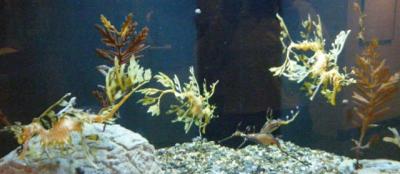
A big percentage of the displays focused on the effects of global climate change and too much carbon dioxide in the air. Exhibits include tanks featuring healthy coral reefs and bleached out coral reefs side by side, so the damage to the coral was evident, as was the capacity for fish to live within each of these reefs. One fun display was where you record yourself giving a weather report. Seeing these displays made Christi think of a retired scientist we had met in the marina in Panama. For most of his career, he was a researcher here at Scripps. Back in his early days as a scientist, they were noticing oddities in normal oceanic patterns and it took quite a while to figure out that these oddities were tied to global climate change. He hadn’t intended to do research on climate change, it just kind of happened upon him as he was studying the ocean. How cool to think of the small part he played in the exhibits here today.
We didn’t get to spend very long in the display area before the feeding show began. We headed back over to the large tank to watch the show. An emcee narrated, talking about kelp forests, San Diego’s ocean ecosystem, and the different creature in the tank. Kelp is a particularly large seaweed that lives in water 68 degrees Fahrenheit (20 degrees Celsius) and below. It grows unbelievably fast more than a foot (1/2 meter) a day, and can grow to be 240 feet (80 meters) tall. It is extremely nutrient rich and is used in dozens of commercial applications, ranging from food to cosmetics to fertilizers, and everything in between. Until 2 years ago, some of the local kelp forests were regularly mowed, with the kelp sold commercially, but apparently, that has stopped. Needless to say, kelp is an important food source and habitat for local marine life. The kelp forests sustain a huge variety of species.
Meanwhile, two divers got into the tank with several buckets of food. They would alternate passing out food to the animals and cleaning the inside of the glass, filters, etc.
When we had passed by the tank earlier in the day, we could see a nice variety of sea life in and amongst the kelp, including a bright orange garibaldi, a barracuda, a shark, and a giant sea bass. But when the food came out, wow! Suddenly, there was sea life galore swarming the divers, including a couple more shark species. Even species that like to hide, like Moray Eels, came out for food. It is kind of interesting to see how many different species can all live together harmoniously in such a relatively small space. Check out the sea bass that is almost as big as the diver!
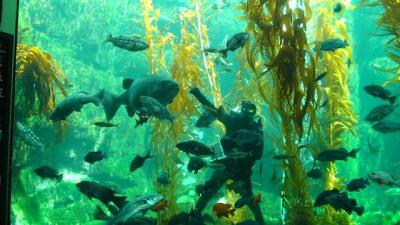
When the show was over, we decided to skip the rest of the museum and get lunch instead. The aquarium had gotten crowded and we were all starting to get hungry. So, we never finished looking at the informational displays, nor did we make it to the touch pools outside. But we did enjoy what we saw, and found the aquarium interesting enough that we would be happy to go back again soon.

Good to know and interesting. Next time we go to san Diego we will check it out.
hope the book comes soon! happy holidays! tom